This article was published in Scientific American’s former blog network and reflects the views of the author, not necessarily those of Scientific American
Eight years ago this month, I jumped in a car with Lockwood DeWitt for the first time, and learned my most valuable lesson in geotripping. You can read a ton of books and blogs. You can take a few geology classes. You can do your own geological touring. But nothing compares to having a geologist take you on a personal tour of sites they know intimately.
How much geology can you pack into one short and rainy trip? Turns out, it's an enormous amount. And with Kilauea still being boring, I figured I'd revisit that road trip. Don't worry. There's plenty of volcanic action, even if the volcanoes have been deceased for millions of years. Come one, come all, and visit a dizzying array of marvelous geology with us!
Day One: Marys Peak, Corvallis, Oregon
On supporting science journalism
If you're enjoying this article, consider supporting our award-winning journalism by subscribing. By purchasing a subscription you are helping to ensure the future of impactful stories about the discoveries and ideas shaping our world today.

View of Marys Peak from Chip Ross Park. Credit: Dana Hunter
Marys Peak is this long, swaybacked mountain in the Coast Range near Corvallis, Oregon. It doesn't look like much from a distance, especially not if you're used to dealing with the majestic as heck, craggy peaks of the Olympics and North Cascades. It looks serene and gentle, like a sweet little old grandmother, beside the young and violent volcanoes of the Cascade Range. But the thing with apparently sweet and boring old mountains is that they're hecking deceptive, like that gray-haired octogenarian who always bakes cookies for the neighborhood kids - with the same hands that shot Nazis dead. And then you find out that was just one episode in a long and exciting life.
Marys Peak has seen some shirt, y'all. Let's have a visit with her and hear some stories.
Hyaloclastite and Slickensides

Hyaloclastite on Marys Peak. Credit: Dana Hunter
One of the very first stops we made was at this enormous shoulder of black rock. This rock has been through it. It was born underwater, when the basalt erupted erupted and shattered. This stuff is composed of sideromelane, a basaltic glass formed when mafic lava is quenched suddenly in water; some tiny wee pillows; plus palagonite and some other assorted things, all welded together into a solid mass. Then, when tectonics heaved Marys Peak from the ocean onto land, this rock was squeezed and scraped along faults, leaving polished and grooved surfaces known as slickensides.
There's so much more geology at this spot! See Lockwood's post on it here.
Spheroidal Weathering and Columns

Basalt columns (left) and spheroidal weathering (right). Credit: Dana Hunter
So underwater basalt lava flows often mean pillow lavas, but not all rounded shapes in an old lava flow are pillows. There's a prime example of this where these columns crop out. When you have a jointed rock like this, the weathering can attack from multiple directions and wear down the corners, forming nicely rounded rocks. This is know as spheroidal weathering. We'll see later how you can tell the difference between this form of chemical weathering and genuine pillows.
As for columns, the key thing to remember is that they form perpendicular to the cooling front. This means you can look at the way the columns are oriented and know things about topography that no longer exists! The orientation of these columns is difficult to suss out from the existing exposures, but this flow may have filled an old stream channel. There are other clues telling us this was a subaerial lava flow: can you pick them out?
Pillow Basalts
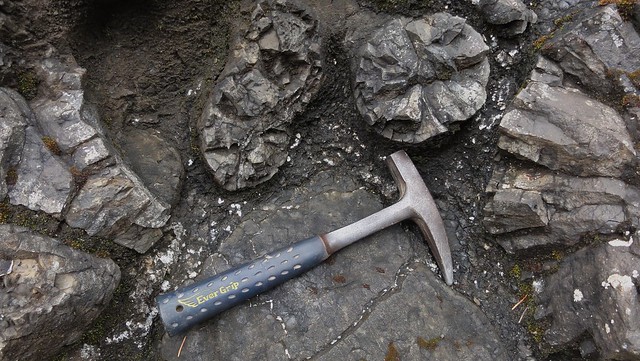
Pillow basalts on Marys Peak. Rock hammer for scale. Credit: Dana Hunter
This exposure is breathtaking. I swear my heart nearly stopped beating the first time I saw it: a mountain of pillow lava atop another mountain. Millions of years ago, the flows that birthed these enormous pillows spilled over a seafloor; today, they reside 4,000 feet in the air. The power of plate tectonics strikes full force here.
The pillows are as fresh as yesterday, and display the stark differences between them and rocks weathered into a spherical shape. You can see the alligator texture of their skin, shiny with rapidly-quenched volcanic glass. You can observe the radial joints created as they cooled and shrank from the outside in – remember joints forming perpendicular to the cooling front? This is what it looks like when the front is all around. Between the pillows is more of our old friend hyaloclastite. And zeolites have formed within and between the pillows, standing out stark white against the black matrix. There's enough geology at this site to keep you busy for years!
Faults
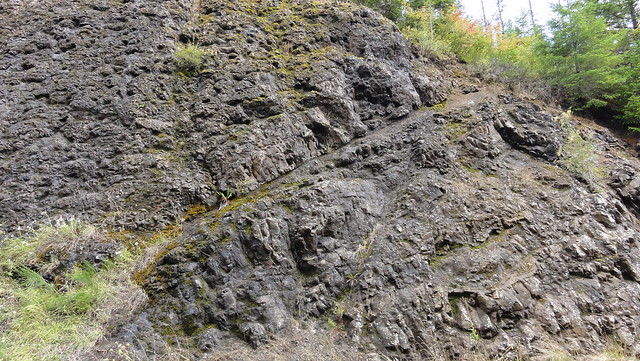
Faults cutting through basalt on Marys Peak. Credit: Dana Hunter
When you have a volcanic island and seafloor thrust up high into the air, you have got faults. And many of the faults on Marys Peak, like these, are obvious even to the amateur. Faults can be fairly small and narrow, like these, or valley-wide zones of crushed and eroded rock. And it's along faults of various shapes and sizes that Marys Peak was thrust up from below sea level to thousands of feet in the air.
Turbedites
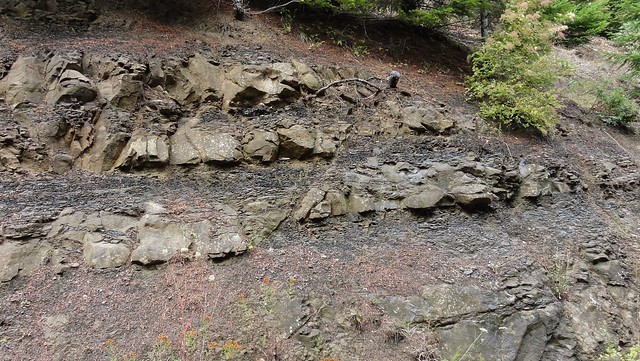
A lovely layer cake of turbedites. Credit: Dana Hunter
Oh, people, this is one of the best things on Marys Peak: turbedites! These layer cakes of sandstone, mudstone, and siltstone tell us so much about the mountain's past. You had dry volcanic land being weathered to form massive amounts of sand and silt. You had steep underwater slopes full of the stuff. And you probably had regular large earthquakes that shook it all loose in massive underwater landslides. These rock layers are full of fragmented plant fossils, attesting to the power of the flows. So very, very awesome. Who says plain brown rocks are boring?!
Gabbro
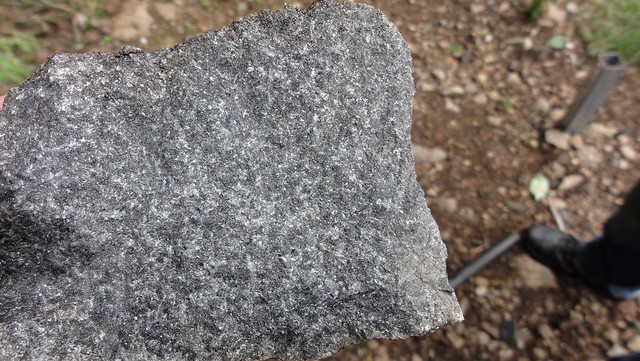
A fresh surface of gabbro at Parker Creek Falls. Credit: Dana Hunter
Ah, the stuff "black granite" countertops are made of. This marvelous mafic rock formed a thick sill above the soft sedimentary layers, and cooled slowly deep underground. But not evenly! Irregularities in its mineral composition suggest this gabbro lost some of its volatile content like water quite rapidly, quenching the rock before its minute remaining olivine could back-react with silica to become pyroxene. Sound complex? The geochemistry of this stone and the stories its mineral crystals tell could keep you busy for a decade.
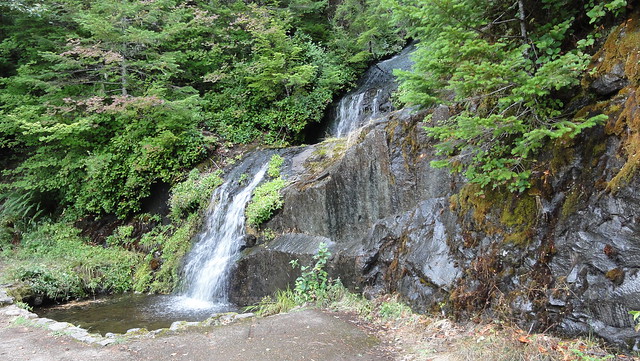
Parker Creek Falls. Credit: Dana Hunter
It's thanks to the gabbro that Marys Peak stands so tall. Miles of softer rock above it have eroded away, a fate the sedimentary rocks below would share if it weren't for that heavy, stout mass of crystalline goodness capping it.
Core Sample

A hole left by a core sample drill in the gabbro at Parker Creek Falls. Credit: Dana Hunter
Here in the gabbro by Parker Creek Falls, you can see evidence of paleomagnetic studies: holes left by drills taking cores of rock. Tiny magnetic minerals in the gabbro froze pointing magnetic north (or south, if the rock cooled during a time when the poles were reversed). We can study their direction and their degree of inclination to determine things like the former cardinal directions of this mass, and roughly how close to the equator it was when it was deposited. Cool!
Parker Creek
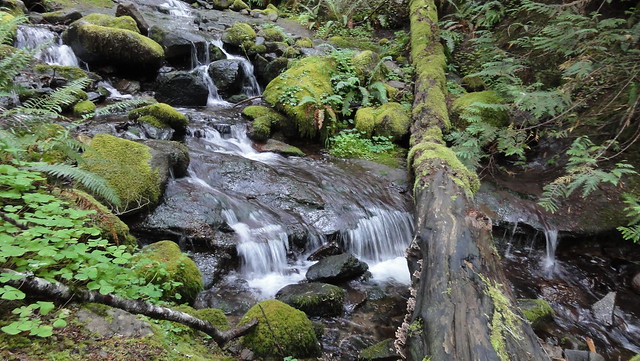
Parker Creek tumbles down rock shelves on Marys Peak. Credit: Dana Hunter
This steep cascading stream has a lot to tell about the morphology of resistant rock layers. And it says it beautifully.
Next up: sidewalk geology and humongous floods!